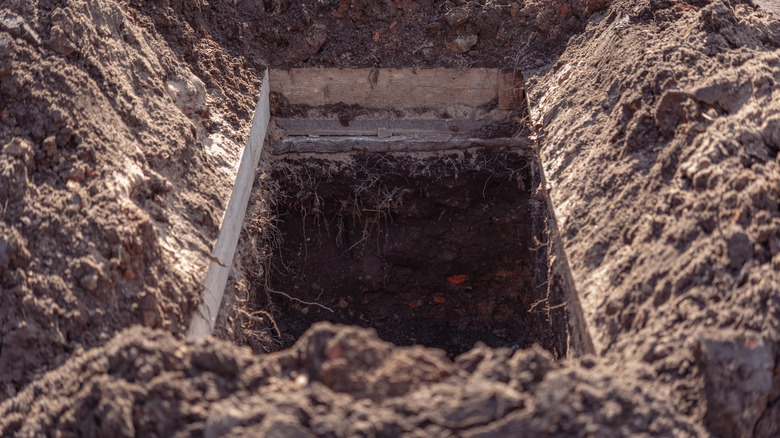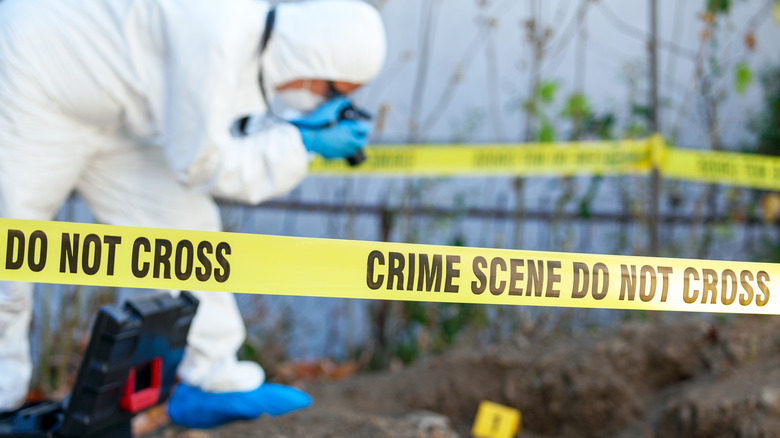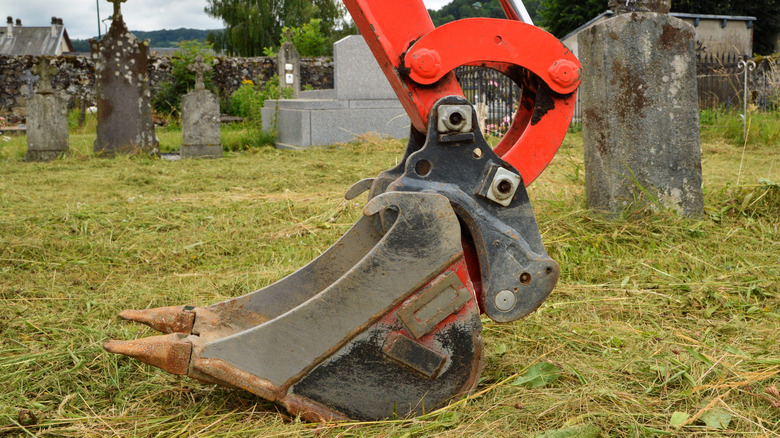Here's How Exhumation Works For Criminal Investigations
It's generally not a good idea to go around digging up bodies. Besides all the blisters on the palms because you forgot your favorite exhumation gloves, the dirt under your fingernails, the horrid stink of putrefaction exuded from the broken Earth, and all the work of actually prying a casket open — who has time? More to the point, The Law Offices of Stephen Bilkis & Associates says that cemetery desecration in New York is a class E felony that could land someone in prison for up to four years. Punishment is harsher in Connecticut, per the Connecticut General Assembly, where disturbing a grave is a class C felony that carries a 10-year prison sentence. Mississippi, meanwhile, seems to care less; Justia cites a maximum of three years for desecrating a grave. All U.S. states, though, and all nations worldwide, carry their own laws and punishments for disturbing the dead.
But if the authorities need to do some grave digging? No problem, provided certain conditions are met. Maybe, as the Manchester City Council points out, there's a lack of burial space for new bodies or an overall renovation of a cemetery. The Royal Borough of Greenwich does say that individuals can request bodies to be exhumed, but need to fill out some paperwork. But in the U.K., U.S., or elsewhere, it's more likely that bodies need to be exhumed because of criminal investigations. Often, this is due to updated testing methods that cast new light on older cases.
Strict requirements for exhumation
Even though law enforcement is generally at liberty to exhume the dead to conduct forensic examinations, criminal investigators still have to demonstrate that there's a good enough reason to do so. Requirements differ from state to state and country to country. In California, for instance, as The Legal Geeks explains, courts necessitate a "substantial reason" to exhume a body, and also take into account "public interest, the conventions of common decency, the wish of the decedent, and the prohibitions of religious law." Such reasons might include using DNA testing to determine the parentage of a child or to find a potential killer, as A&E explains; the latter can help even decades after the fact. And speaking of religious law, the City of York Council in England describes needing to apply for two different types of exhumation licenses depending on whether or not the deceased was buried on consecrated or unconsecrated grounds.
As soon as criminal investigators get the go-ahead to exhume a body from civil and/or religious authorities, they've got to abide by certain procedures at the time of the exhumation. Aftermath tells us that local or state officials might be present to make sure the whole thing is done correctly, as well as police and funeral directors. Though generally advised to stay away because of the emotional toll, family members can show up, too, no matter the difficulty of such a choice. As Embrace Funeral Services says, countries like Singapore also ask priests or monks to conduct a religious rite over a burial site before an exhumation begins.
Preserving the exhumation site
When conducting the actual exhumation, investigators have to follow ultra-strict, painstaking measures. As the U.S. Department of Justice outlines, investigators ought to follow similar principles as archaeologists. They ought to take photographs of every phase of the exhumation, including the surrounding area, and layout markers to identify objects in the environment and various phases of exhumation. There ought to be a "number/letter code" devised for labeling items at the dig, and nothing should be removed from the grave until the entire grave is exposed. Investigators should note the original "position and orientation" of the body before placing individual bones and objects in carefully labeled bags and containers. The original site dirt should not be discarded but kept. On and on it goes, including specific instruments to use in specific situations, leaving a clear separation between dig soil and non-dig soil, and watching out for seeping groundwater.
Aftermath tells us that exhumations are usually conducted not by people with shovels, but a combination of heavy machinery and manual labor. The soil has to be soft enough, meaning that winter months might be out of the question. The time of day might also matter. Before beginning any digging, artifacts on the top of the grave — tombstones, flowers, etc. — have to be moved. And before touching any remains, investigators have to be extremely careful lifting a coffin out of the ground. Eventually, remains and other objects can be sent to a lab for testing.


